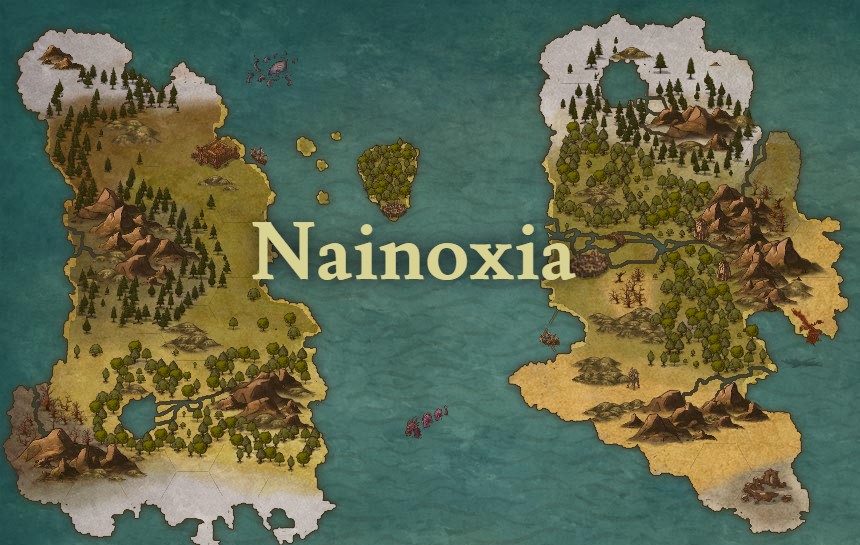Krenshar
The Krenshar are a species of feline predators native to the mid-southern part of Tolhera north of the dessert. They form in packs of 6-12 and sustain themselves through hunting, claiming other creatures kills, and scavenging. Their most distinctive characteristic is the peeling facial skin which reveals their skull, muscles and teeth, which is a very effective scare mechanism for prey and competitors alike.
Basic Information
Anatomy
The Krenshar has a strong and well developed neck and forequarters, but relatively underdeveloped hindquarters. The rump is rounded rather than angular, which prevents attackers coming from behind from getting a firm grip on it. The head is wide and flat with a blunt muzzle and broad nose.Their ears are pointed and each foot has four digits, which are webbed and armed with short, stout and blunt claws. The paw-pads are broad and very flat, with the whole under-surface of the foot around them being naked. The females are usually large and more aggressive than the males, reinforcing their social hierarchy. Their scull is one of the most powerful of the carnivores, surpassing that of wolves, and their teeth are dual purpose, the front ones being long and sharp for biting and gripping prey, and the back ones being flatter for crushing bone, which is useful for taking down prey and scavenging. The skin of their face is their most striking characteristic, as it is flexible enough to peel back, revealing their muscle, bone and teeth. Their stomach enzymes are also relatively strong and as such they can more safely eat carcasses left by other predators.
Ecology and Habitats
They inhabit grasslands and temperate forests.
Dietary Needs and Habits
They act aggressively toward each other when feeding, but compete mostly through speed of eating, rather than by fighting. They feed in turns of ranking, and as many as can fit will eat at the same time. It is common then for the weakest males to eat last or not at all sometimes, having to compete with the others for a spot at the body, or use their teeth to break the bones and feed off the marrow once the meat is done.
Additional Information
Social Structure
Social Behaviour:
They form in groups of 6-12 wand are very sociable. Females dominate males, with even the lowest ranking females being dominant over the highest-ranking males. It is typical for females to remain with their natal pack, whereas males typically disperse from their natal pack at the age of 2½ years. The pack is a tight knit society, where members that have found themselves in the tribe stay for life and usually maintain their rank for life as well. High-ranking Kreshnars maintain their position through aggression directed against lower-ranking pack-members. Kreshnar hierarchy is nepotistic, the offspring of dominant females automatically outrank adult females subordinate to their mother. However, rank in Kreshnar cubs is greatly dependent on the presence of the mother, low-ranking adults may act aggressively toward higher-ranking cubs when the mother is absent. Although individual Kreshnars only care for their own young, and males take no part in raising their young, cubs are able to identify relatives as distantly related as great-aunts. Also, males associate more closely with their own daughters rather than unrelated cubs, and the latter favor their fathers by acting less aggressively toward them.Hunting Behaviour:
Krenshars use solitary scouts to drive prey into the waiting clutches of the pack. The scout appears from hiding, uses its peeling skin to scare the prey, which is then chased towards the waiting pack. Alternatively, a pack of them is more than willing to approach a kill claimed by another species or pride, and as the packs strongest approach, they peel their skin in an attempt to intimidate the previous owner into fleeing. Lastly they also seem perfectly happy to find a carcass that has been already fed from from other predators, and scavenge what they can from it.Domestication
They can be domesticated as they have strong social bonds and respect social structure, but it is necessary to raise them from birth.
Facial characteristics
Facial skin peels back revealing the muscle and bones, and is used to scare prey, defend kills, and claim carcasses.
Geographic Origin and Distribution
They live in Tolhera, and groups of them are in the southern parts of the empire, north of the dessert.
Credit to the Spotted Hyena Wikipedia page, a lot of content was taken and altered.
Krenshar CR: 1/2
Medium beast, neutral
Armor Class: 12
Hit Points: 21 (3d10 + 6)
Speed:
40 ft
STR
14 +2
DEX
14 +2
CON
14 +2
INT
6 -2
WIS
10 +0
CHA
8 -1
Skills: Stealth +4, Perception +2
Senses: Passive Perception 12
Languages: -
Challenge Rating: 1/2
Keen Hearing and Smell. Advantage on Wisdom (Perception) checks that rely on hearing or smell.
Pack Tactics. The Krenshar has advantage on an attack roll against a creature if at least one of the Krenshar’s allies is within 5 feet of the creature and the ally isn’t incapacitated.
Actions
Bite. Melee Weapon Attack: +4 to hit, reach 5ft, one target. Hit: 7 (2d4 + 2) piercing damage.
Skin Peel: Every creature within 30ft cone that can see the Krenshar must make a DC 12 wisdom saving throw or be Frightened of it. Other Krenshar are immune to this ability.



